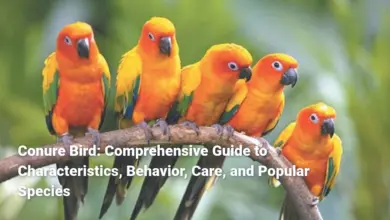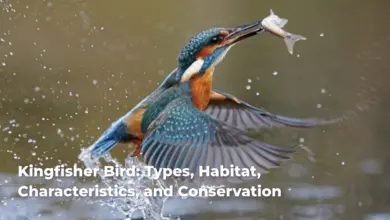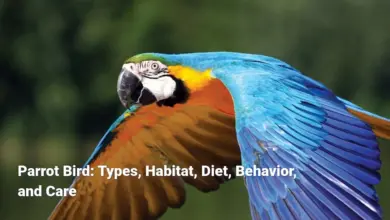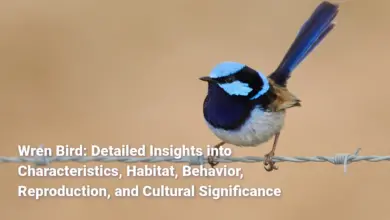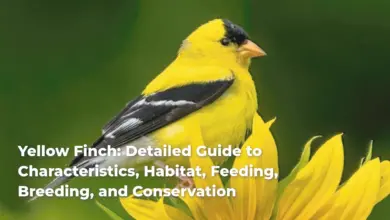Titmouse Bird: A Comprehensive Study of Species, Habitats, and Conservation
Titmouse Bird: An In-Depth Look
The Titmouse Bird, specifically the Tufted Titmouse (Baeolophus bicolor), is a delightful woodland creature that captures the hearts of bird watchers and nature enthusiasts alike. With its distinctive tufted crest and cheerful disposition, this small bird brings joy and life to its habitat. Commonly found in the eastern United States, the titmouse not only enchants with its playful antics but also plays an essential role in local ecosystems.
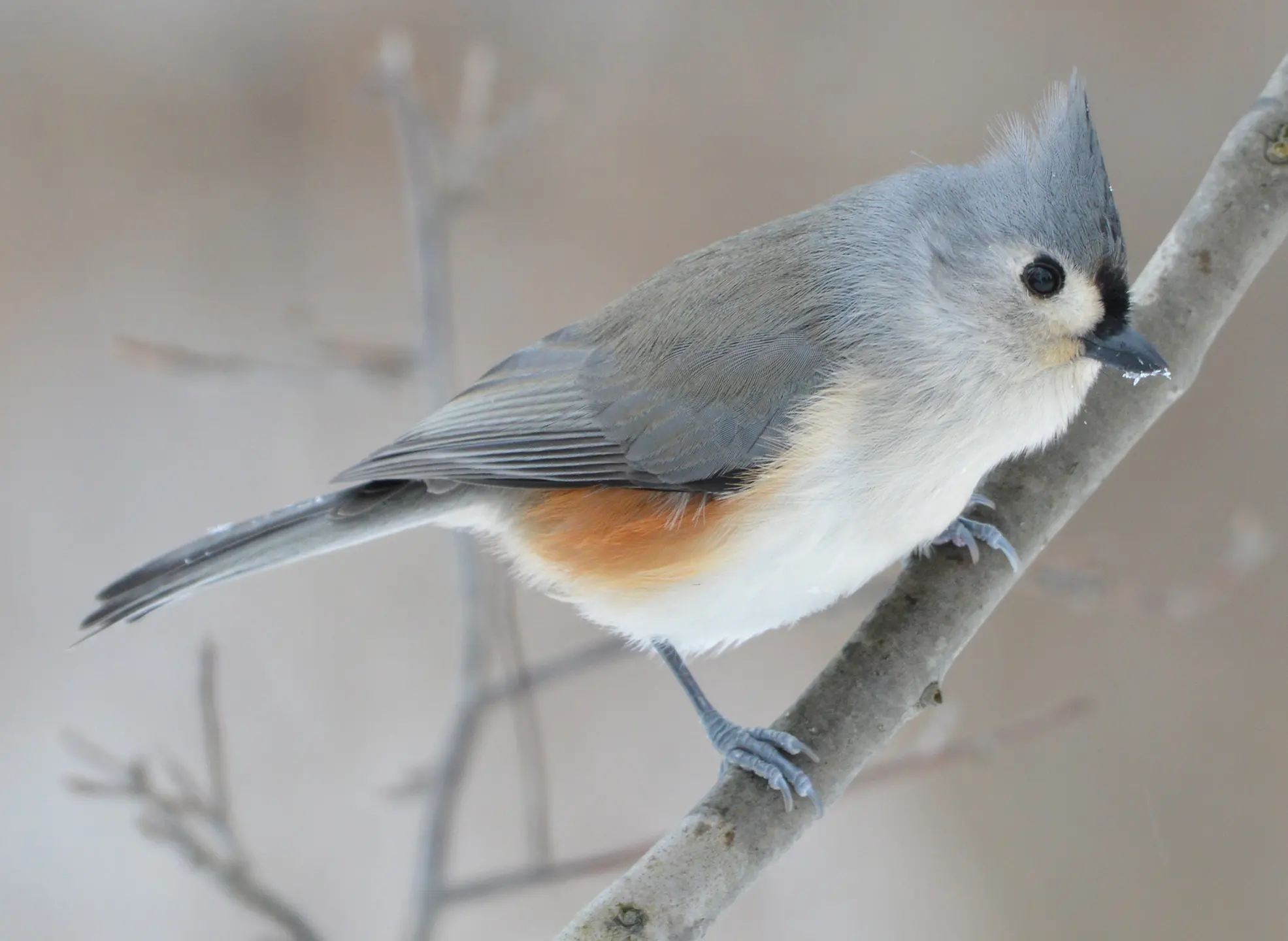
From its charming vocalizations that echo through the woods to its acrobatic foraging techniques, every aspect of the titmouse’s life is a testament to nature’s beauty and complexity. In this article, we will explore the intricate details of titmouse birds, shedding light on their characteristics, behaviors, habitats, diets, and their interactions within the ecosystem.
Characteristics of Titmouse Birds
Titmice belong to the family Paridae, characterized by their small size and energetic nature. Their most notable physical feature is their tufted crest, which resembles a playful brush, adding to their charming appearance. Beyond this, they possess a lively demeanor that turns every day into a display of acrobatic feats among the branches. Despite being small averaging between 11.5 cm to 20 cm in length (about 4.5 to 8 inches) their presence is magnetic.
Their coloration varies but is generally a comforting palette of soft greys, whites, and occasional peachy undertones on the flanks. Much like a gentle fog settling over the forest floor, their muted tones allow them to blend seamlessly into their natural surroundings while highlighting their distinctive features, such as the characteristic black patch above their bills.
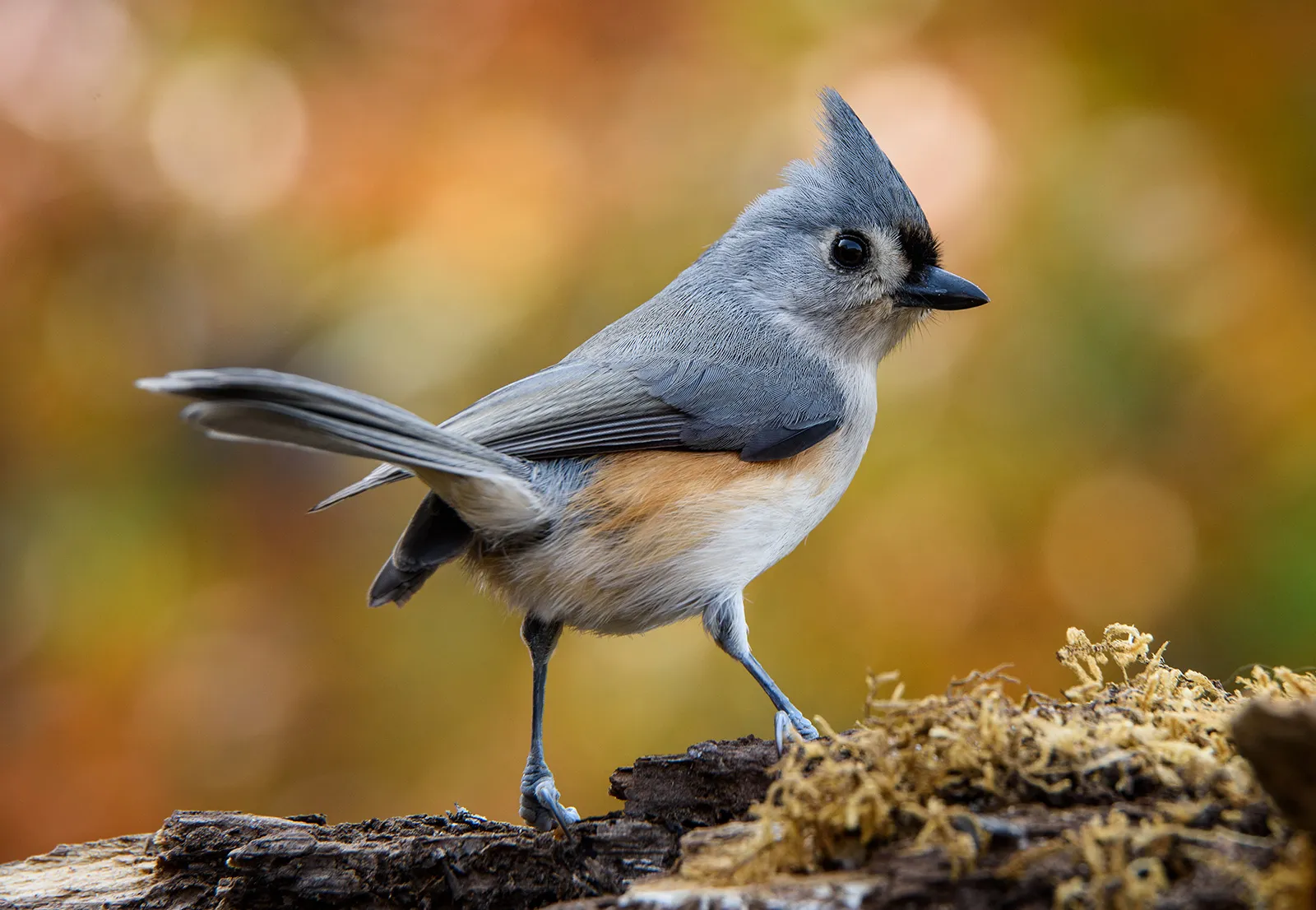
The titmouse’s bill is round and robust, tailored for cracking seeds and nuts with impressive strength. This small yet powerful tool reflects the bird’s adaptive nature an engineering marvel of evolution akin to a tiny jackhammer suited for nature’s secrets. They are often seen hanging upside down, a skillful maneuver that speaks to their agility and resourcefulness. All these traits not only serve practical purposes in their navigation through the trees but also make them one of the more captivating birds to observe in any setting, from dense forests to suburban yards.
Physical Features
The titmouse, particularly the Titmouse Bird, stands out for its distinctive physical features, which grant it both practical benefits and an endearing visual appeal. As mentioned, the average size of the Titmouse Bird is about 5.5 to 6.3 inches (approximately 14-16 cm) long, weighing between 0.6 to 0.9 ounces (18-26 grams). Despite this small size, their stocky build and prominent heads make them appear more robust, like tiny chubby clouds flitting through the forest.
The most notable physical trait of titmice is their tufted crest. This tiny crown is not only stunning but also serves functional purposes birds can raise and lower their crests to express behavior like excitement or alarm, making it a living barometer of their mood. Their large, dark eyes contribute to their expressive faces, projecting a nearly human-like curiosity that draws in observers who stumble upon them.
The soft, silvery-grey plumage of their dorsal side, coupled with snowy-white underparts, creates a striking contrast. The extra peachy wash along the flanks acts as a delicate reminder of sunlight filtering through the leaves a visual metaphor for warmth and care. Such coloration allows them to adapt seamlessly to various environments, from the leaf-laden forest floors to bustling backyards.
The functional aspects of their feet can’t be overlooked. They are uniquely adapted for gripping branches and holding seeds, demonstrating fine motor skills as they retrieve food from crevices. Much like a master craftsman wielding a tool, titmice display dexterity uncommon among smaller birds. Their methodical way of feeding, characterized by a mixture of hopping and hanging upside down, mirrors the graceful choreography of a ballet dancer a dance of survival and delight.
Color Variations
One fascinating aspect of the titmouse is its color variations, which can be as unique as fingerprints among human beings. The Titmouse Bird exhibits a generally soft silvery-grey upper plumage, but individual birds may display differences due to age, health, and changing seasons. During late summer, as feathers wear from constant use, the intensity of their vibrant plumage may fade, showcasing a natural, rustic elegance that further underscores their adaptability.
A key identifying factor is the sleek black patch located above their bill, which gives them a distinct, snub-nosed appearance. This patch can sometimes become less pronounced in older individuals, showcasing a sort of nature’s timeline a reminder of life lived among the branches.
While the Titmouse Bird holds a uniform color scheme, other species such as the Oak Titmouse exhibit different shades. For instance, the Oak Titmouse leans towards a nondescript grey-brown plume, where subtle variations in tone serve as camouflage against the oak bark in its typical habitats. Similarly, the Bridled Titmouse displays a striking contrast, characterized by its distinct facial markings that highlight the diversity within the family.
These color variations are more than aesthetic. They are a practical adaptation, serving purposes of camouflage, social signaling, and mating rights. Just like the changing leaves of autumn signal the season’s shift, the titmouse’s coloration reflects the interplay of environmental changes, genetics, and the passage of time in their life cycle.
Behavior Patterns
When it comes to behavior patterns, titmice are the epitome of lively and interactive birds. Renowned for their acrobatic prowess, they can often be seen performing remarkable feats of agility as they flit from branch to branch, hanging upside down in search of insects, seeds, and other tasty morsels. This behavior not only makes them entertaining to observe but also highlights their exceptional adaptability to various feeding strategies.
The vocalizations of titmice are another captivating element of their behavioral repertoire. Their songs resonate through the woods with a distinct, melodic whistle described as a “peter-peter-peter.” This lively tune acts as both a personal calling card and a way to communicate with fellow titmice, providing intricate social layers to their existence. Just as a celebration is marked by music and dance, the titmouse uses its voice to express joy and connectivity in its community.
Moreover, titmice are incredibly social creatures, often seen joining mixed-species flocks with chickadees, nuthatches, and woodpeckers while foraging. This behavior mirrors the cooperative nature found in human communities, as they share food resources and benefits from each other’s vigilance against predators. Their assertive demeanor allows them to dominate feeders, showcasing a competitive spirit akin to that of eager children at a candy store.
Interestingly, while they exhibit a social nature, they also prioritize pair bonding outside of the breeding season. This behavior speaks to their progressive approach as both nurturers and defenders of their territory an echo of their devotion to family units. They refine their nest-building skills, learning from previous seasons and passing knowledge along to their young, cultivating a sense of heritage that encapsulates both instinct and learning.
Habitat of Titmouse Birds
Habitat preferences are crucial to understanding the titmouse’s ecological role. The Titmouse Bird thrives in deciduous forests, mixed woodlands, and urban environments where dense canopies provide safety and food sources. They prefer areas enriched with diverse tree species much like a gourmet restaurant offers variety on its menu. Suburban gardens, parks, and orchards also serve as ideal feeding grounds, allowing for seamless coexistence with humans.
The habitat of the Oak Titmouse diverges slightly, as it gravitates more towards oak woodlands, showcasing preference for mature trees that provide both nesting sites and abundant sources for foraging. This species embodies the focused defender of its environment, demonstrating the symbiotic relationship between flora and fauna.

Both species display an impressive non-migratory behavior, showcasing their preference for year-round residence within their geographical limits. This adaptability is reflected in their response to human presence, incrementally altering their ranges as suburban areas expand, highlighting their resilience to environmental changes.
Just as a musician adapts their composition to suit the venue, titmice adapt their living environments according to the richness of resources and shelter provided. Regardless of whether they perch on a supernatural branch in a dense woodland or flit through an ornamental garden, their presence enhances biodiversity, lending character to their habitats.
Preferred Environments
Choosing where to call home profoundly affects the Titmouse’s lifestyle. The Titmouse Bird prefers habitats where mixed species coexist, drawing on the benefits of variability in both flora and fauna. They flourish particularly well in mature deciduous forests that provide ample opportunities for foraging and nesting, ideally interspersed with areas of understory vegetation for protection from predation.
Their vibrant personalities are witnessed as they dart between trees, navigating branches with finesse akin to performers on a stage. As they explore, their foraging techniques reveal their adaptability; they often engage in “barking” inspecting tree bark for insects and larvae. Parks and urban gardens, enriched with bird feeders, provide adaptations for survival, showcasing their ability to thrive in increasingly human-altered environments.
Conversely, the Oak Titmouse predominantly inhabits warm, dry oak or oak-pine woodlands, reflecting specialized preferences for specific tree families. Such environments reflect a meticulous selection process, as the oak trees themselves provide essential food sources while forming natural shelters for nesting.
Over time, these habitat preferences underline the role of titmice as critical players in their ecosystems, contributing to seed dispersal and insect population control. The coexistence of various plants and animals fosters a balanced environment, illustrating how the presence of titmice enriches local flora with their keen behaviors.
Geographic Distribution
Geographic distribution plays a vital role in defining the habitat and survival strategies of the Titmouse. The Titmouse Bird primarily occupies the eastern region of the United States, with its range extending from the southern parts of Canada down to northern Texas. This versatile bird can be found in a variety of settings, including deciduous and mixed forests, suburban areas, and garden spaces. Their adaptability allows them to flourish across diverse elevations, although they tend to favor lower altitudes, rarely venturing above 2,000 feet.
In their expansion, titmice have exhibited remarkable resilience, capitalizing on urbanization that has altered their geographic distribution. The establishment of backyard bird feeders and artificial nesting facilities has facilitated their growth in suburban areas, demonstrating their ability to perform amidst change.
Conversely, the Oak Titmouse is more localized, inhabiting primarily the oak woodlands of California and Northern Mexico. Their less extensive range emphasizes the species’ niche adaptation to specific ecological conditions, showcasing their deep bond with their preferred environment. This specificity creates a compelling contrast to the adaptable Titmouse Bird, illustrating how different ecological niches can coexist within the broader family dynamics of bird species.
This geographical dichotomy not only speaks to the adaptability of titmice but also reflects the intricate network of dependencies in ecosystems. Their distribution correlates directly with habitat availability and human activities, accentuating the dynamic interplay between species and their environments.
Nesting Habits
Nest-building serves as a central aspect of the titmouse life cycle, showcasing resourcefulness and adaptability. The Titmouse Bird is recognized as a secondary cavity-nester, meaning it depends on pre-existing holes made by larger birds like woodpeckers. Their nests can be found in peculiar places, from tree cavities to artificial nesting boxes, even in hollow fence posts. This variability illustrates how they can make use of anything at their disposal a handy source of shelter akin to a tenant moving into a cozy apartment.
Nesting typically begins around late March, with the female actively constructing the nest utilizing soft materials like leaves, fur, moss, and even hair taken from living creatures. This behavior exemplifies the titmouse’s involvement in its ecosystem, as they assist in the recycling of organic materials. Average nesting heights can range from as low as 0.6 meters (2 feet) to as high as 27 meters (90 feet), offering a variety of options that reflect strategic choices against potential predators.
During construction, nests are often lined with the same meticulous care that one would bestow on a cherished keepsake. The selection of materials complements their environment, showcasing a symbiotic relationship with the resources around them. Clutch sizes typically range from 3 to 9 eggs, with females incubating them for 12 to 14 days, emphasizing their nurturing instincts.
The nesting habits of titmice reflect broader ecological themes within avian communities, showcasing their adaptability, ingenuity, and spirited companionship with the environments they inhabit. Each nesting season acts as a renewal of life, underscoring the essential components within the web of existence that connects species with their habitat.
Diet of Titmouse Birds
The diet of the titmouse is as varied as its behaviors and habits. Primarily insectivorous, titmice have a profound reliance on insects that compose a significant portion of their meals, especially during the warmer months. Approximately two-thirds of their summer diet consists of insects, including caterpillars, beetles, and ants, effectively making them vital pest controllers in their habitats.
Their dietary habits extend to seeds and nuts, giving the titmouse a diverse menu that adapts to seasonal changes. Winter sees a shift towards hard seeds and nuts, particularly acorns nature’s snack that fuels their energy amid colder months. They are frequent visitors at backyard feeders, eagerly partaking in sunflower and safflower seeds, with their small yet robust beaks proving adept at cracking open even the toughest shells.
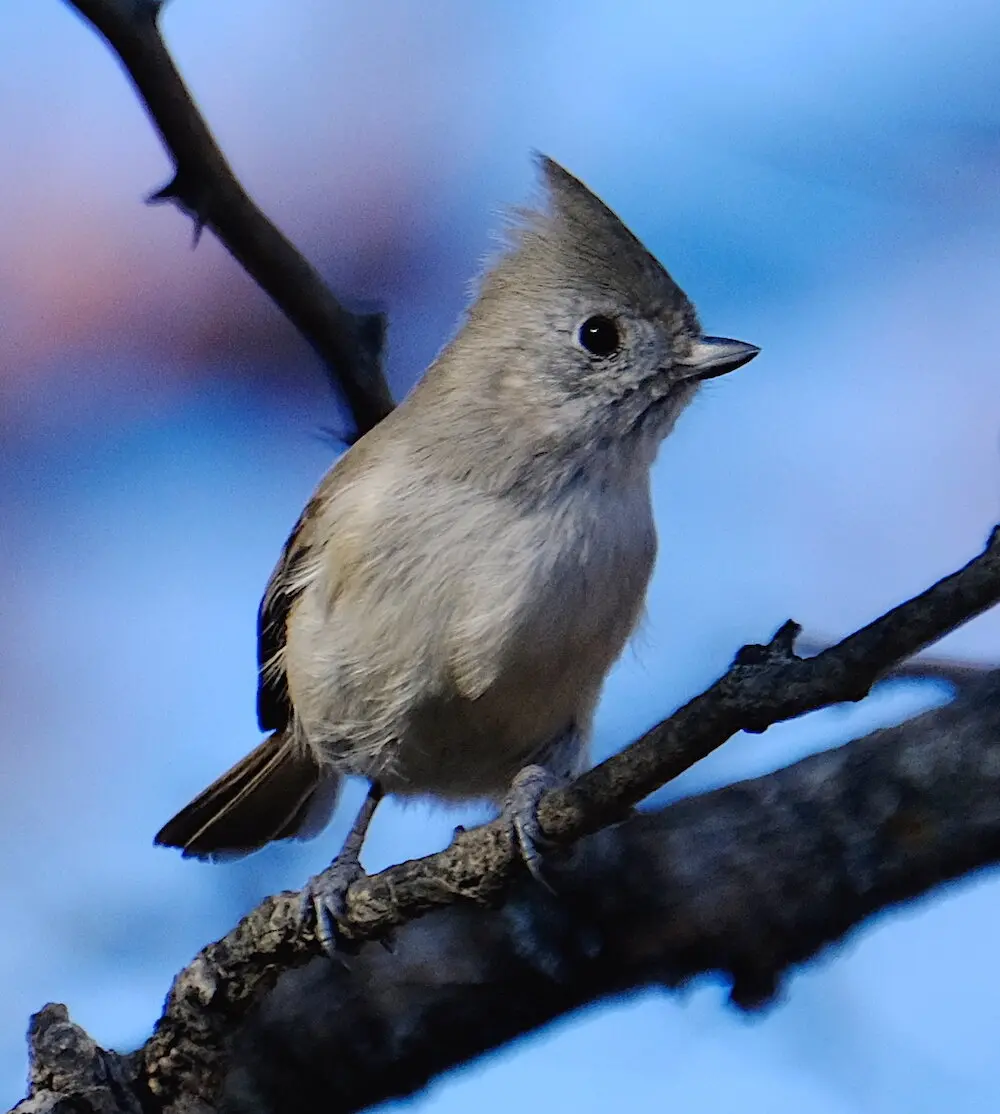
Fruit also plays a part in their diet, particularly in seasons when berries and fruits reach ripeness, providing essential vitamins and sweetness that further diversify their food intake. They exhibit diverse foraging behavior, traveling across landscapes to seek nourishment, ensuring a well-balanced diet across varying seasons.
This flexibility in diet underscores the titmouse’s resourcefulness and ability to adapt its feeding strategies according to available food sources. A snapshot of their diet offers a lens into their survival strategies, emphasizing not just the pursuit of sustenance but a deeper engagement with the environment around them.
Primary Food Sources
When delving into the primary food sources of the titmouse, it’s essential to understand the seasonal shifts that impact their dietary habits. During summers, when food is abundant, titmice predominantly consume:
- Insects (approximately 60-70%):
- Caterpillars
- Beetles
- Ant eggs and larvae
- Flies and spiders
Insects serve as vital sources of protein during the breeding season, supporting parental care as insects provide essential nourishment for growing chicks.
- Seeds and Nuts (20-25%):
- Acorns (especially important in winter)
- Black oil sunflower seeds
- Safflower seeds
In colder months, nuts become critical, showcasing the titmouse’s ability to adapt its diet according to seasonal needs.
- Fruits (10-15%):
- Ripe berries (blueberries, mulberries)
- Holly and pyracantha berries
In late summer and early autumn, fruits serve as sources of hydration and energy.
Feeding Techniques
Titmice display several clever feeding techniques that showcase their adaptability and intelligence. Typically, when foraging, they employ a mix of methods that highlight their nimbleness and ingenuity. One prominent technique involves exploiting their agility to hang upside down as they navigate branches, allowing access to otherwise obscure food sources nestled beneath leaves or within crevices.
They adeptly pick up seeds with their small feet, manipulating them towards their strong beaks to crack them open. This technique mirrors an artist at work, using unique tools to triumph over challenges an example of the bird’s impressive craftsmanship in the art of foraging.
Moreover, food caching an instinctual behavior plays a significant role in their survival strategy, allowing them to store surplus food items to access during scarcer months. Before winter, they can be seen meticulously stashing seeds in hidden spots within their territory, acting like prudent savers preparing for future needs.
A distinctive aspect of their feeding behavior is their cooperative approach when foraging in mixed-species flocks. By associating with other birds, titmice amplify the collective vigilance against potential predators, enhancing survival chances while allowing them to focus on their feeding. This social disposition underscores their intelligence and understanding of community dynamics creating harmonious foraging experiences that resonate beyond mere sustenance.
Seasonal Dietary Changes
The seasonal dietary changes exhibited by titmice play a critical role in their survival and adaptability. These birds are adept at adjusting to the availability of food, which shifts with each season’s rhythm.
- Spring and Summer:
- During the warm months, titmice primarily rely on abundant insects, with their diet shifting to encompass active foraging for caterpillars, spiders, and various larvae. This seasonal dependency highlights the bird’s critical role in pest control within their habitat during breeding and rearing periods.
- Autumn:
- As summer transitions to autumn, titmice begin their shift towards storing food. They transition to seeds and nuts, preparing for the colder months ahead. In this phase, they aggressively forage for acorns and sunflower seeds, often seen stashing them in tree crevices for later use.
- Winter:
- When the chill sets in, titmice’s winter diet shifts considerably to focus heavily on nuts, seeds, and berries. They can often be seen at backyard feeders, eagerly pecking at suet and high-energy foods, reflecting their survival strategy. This adaptability showcases their resourcefulness, allowing them to thrive despite challenging environmental conditions.
Through each season, their ability to pivot and adjust dietary habits illustrates a remarkable harmony with the environment, connecting their survival to the intricate dance of ecological balance around them.
Species of Titmouse Birds
Titmice come in several distinct species, each exhibiting unique characteristics and adaptations to their environments. While the Titmouse Bird is commonly recognized, other species add to the diversity within this charming family of birds.
Eastern Tufted Titmouse
The Eastern Tufted Titmouse (Baeolophus bicolor), often recognized for its beautiful plumage and boisterous nature, is predominantly found in the eastern parts of North America. Characterized by its distinctive tufted crest and charming melodies, this species has won the favor of both birdwatchers and casual observers alike. They thrive in mixed woodlands and suburban habitats, embracing a lifestyle filled with endless energy and activity.
- Identification:
- Size: Approximately 5.5 to 6.3 inches (14-16 cm)
- Weight: 0.6 to 0.9 ounces (18-26 g)
- Plumage: Soft grey upper body, snowy white underparts, peachy flanks.
- Vocalizations:
- Melodic “peter-peter-peter” whistle.
- Habitat:
- Preferred habitats include deciduous and mixed forests, gardens, and parks, taking full advantage of the resources provided through human interaction.
Oak Titmouse
The Oak Titmouse (Baeolophus inornatus) lends a different flavor to the titmouse family, primarily dwelling in oak woodlands of California. Their understated gray-brown appearance may seem less remarkable compared to their more flamboyant cousins, yet their straightforward demeanor and specific habitat preferences depict an evolved resilience to environmental pressures.
- Identification:
- Size: 4.5 to 5.5 inches (11-14 cm)
- Weight: 0.3 to 0.7 ounces (10-21 g)
- Plumage: Nondescript gray-brown, slightly darker above and paler below.
- Habitat:
- Thrives in warm, open oak or oak-pine woodlands, reflecting their specific dietary needs tied closely with oak forests.
Bridled Titmouse
The Bridled Titmouse (Baeolophus wollweberi) showcases a distinct appearance characterized by its black-and-white facial patterns. Primarily inhabiting the mountainous regions of southwestern USA, this avian artist navigates the higher elevations with the grace of an experienced climber.
- Identification:
- Size: Approximately 4.0 to 5.1 inches (10-13 cm)
- Weight: Approximately 0.3 ounces (10 g)
- Plumage: Notable for its striking facial swirl of black and white.
- Habitat:
- Prefers oak and pine-oak woodlands, often seen in communal foraging flocks alongside other bird species.
The similarities and differences among these species highlight a remarkable adaptability to their respective environments, underscoring the importance of ecological niches in maintaining biodiversity.
Conservation Status of Titmouse Birds
Currently, the titmouse birds, particularly the Tufted Titmouse (Baeolophus bicolor), are rated as “Least Concern,” signaling a relatively stable population amidst environmental changes. This classification, however, masks underlying dynamics that necessitate attention.
Threats and Challenges
While the titmouse population appears stable, several challenges threaten their long-term viability. Notably:
- Habitat Loss:
- Urbanization, agricultural practices, and deforestation alarmingly contribute to the fragmentation of critical habitats. These changes place additional pressures on local bird populations, leading to potential declines in food availability and nesting sites.
- Climate Change:
- Climate variations lead to habitat disruptions, affecting food sources and altering breeding cycles. The introduction of extreme weather phenomena stresses species adaptively, often limiting their range and survival.
- Predation and Competition:
- Increased predation pressures and competition for resources can inhibit titmouse populations. Natural predators, as well as competing avian species for food and nesting sites, can complicate their survival rates.
These challenges speak to the broader ecosystem dynamics in which titmice exist, highlighting the need for proactive conservation measures to maintain suitable habitats and enhance population stability.
Conservation Efforts
Conservation initiatives surrounding titmice focus on habitat preservation, dietary sustainment, and community engagement. To mitigate the threats, several efforts have been established:
- Habitat Preservation:
- Advocacy for the protection of forested areas remains crucial. Conservationists emphasize preserving unbroken habitats for nesting and accessing food resources integral to titmouse survival.
- Community Outreach:
- Engaging local communities through educational programs about the ecological importance of nurturing backyard habitats increases awareness and promotes the installation of feeders that cater to titmouse dietary preferences.
- Research and Monitoring:
- Continued research on titmouse behavior, population monitoring, and adjustments to conservation strategies according to findings ensures that management efforts remain effective over time.
By addressing the challenges of habitat loss, increasing public awareness, and advocating for community participation in conservation efforts, there exists significant potential for securing the future and stability of titmouse populations across North America.
Successful Recovery Stories
Successful recovery stories highlight the resilience of the Titmouse Bird and its flourishing populations across various regions in North America. Observational studies reveal a population increase of about 1.5% annually between 1966 and 2015, illustrating effective conservation measures displaying successful outcomes in various habitats.
- Population Growth:
- Tightly linked with forest restoration efforts in regions like Wisconsin, titmouse numbers rise, evidenced through Christmas Bird Counts and other surveys, reinforcing community involvement in preserving natural spaces.
- Habitat Management:
- The gradual recovery of northeastern forests allows titmice to thrive, with data reflecting their return to areas where they were previously sparse. Their adaptability showcases an encouraging trend towards resurgence and stability.
- Community Support:
- Bird feeding practices, resilient among suburban dwellers, evoke widespread positive sentiment for the species’ well-being, influencing public support for further conservation movements. These combined efforts manifest successful collaborative work and enhance community spirit surrounding local avian populations.
Emphasizing these success stories inspires further conservation-oriented practices, providing a hopeful outlook for titmouse populations amid ongoing environmental challenges. Through the efforts of individuals and communities, titmice will continue to occupy their rightful place in our natural landscapes while actively engaging us in their whimsical ways.
Relationships with Other Birds
Titmice occupy a complex web of interactions within their avian communities, showcasing both competition and cooperation with various bird species. Their social dynamics, especially concerning feeder interactions and foraging habits, demonstrate an integral role in the ecological community.
Interactions with Other Species
Titmice are often recognized for their sociable nature, particularly during foraging. They frequently join mixed-species flocks with chickadees, nuthatches, and even woodpeckers, engaging in cooperative foraging practices. These interactions are reflective of a larger communal framework, allowing for greater vigilance against predators and more efficient food acquisition methods.
- Shared Foraging:
- The presence of titmice often attracts a variety of other birds, resulting in dynamic feeding experiences. Their assertiveness can dominate feeding sites but also enhances collective awareness when threats emerge, creating a symbiotic dynamic that benefits all species involved.
- Vocal Communication:
- Titans boast intricate vocalizations that facilitate social interaction. These calls not only serve as alarm signals but also foster cooperative relationships among species in mixed flocks. Their voices echo through the treetops, vibrant with the essence of communication essential for survival within avian societies.
- Community Dynamics:
- The social structures formed among species fluctuate seasonally but often focus on shared roosting sites during colder months. These arrangements reflect their adaptability to varying environmental conditions, fostering rich communal ties that amplify their overall foraging success.
In these interactions, the titmouse serves as a bridge, linking various birds while enriching the species’ diversity within shared habitats. Their relationships with other birds embody a harmonious balance that highlights the ingenuity within nature.
Competition for Resources
However, competition also arises alongside cooperation. At feeders, titmice portray assertive behaviors that often allow them to dominate food sources over smaller birds like wrens and sparrows. Such competition generates micro-ecologies and influences which birds thrive in specific settings.
- Feeder Dynamics:
- At backyard feeders, the titmouse’s assertiveness demonstrates their capacity to monopolize resources, often challenging smaller birds and ensuring priority in access to food. This resource acquisition stance leads to fascinating behaviors reflective of avian hierarchies in action.
- Nesting Site Competition:
- With nesting primarily in existing cavities, titmice often find themselves in competition with woodpeckers and other hole-nesting species for suitable breeding locations. This dependence on pre-existing structures compels titmice to establish territories while managing overlap with competitors, leading to intricate dynamics during breeding seasons.
Additionally, as they participate in mixed-species flocks, competition often intertwines with cooperation, creating complex social systems that facilitate survival through collaboration even amid rivalry. Their roles navigate between being competitors and allies, reflecting a nuanced acknowledgement of the interdependence that dominantly characterizes avian communities.
Role in Ecosystem
The titmouse’s presence and behavior significantly influence local ecosystems. By effectively managing insect populations and enhancing seed dispersal through their foraging, these small birds contribute essential ecological functions a role much larger than one might assume given their diminutive size.
- Insect Predation:
- By consuming a variety of insects, particularly during the breeding season, titmice help control populations of potential pests. This natural pest control enables healthier gardens and forests, promoting biodiversity by maintaining the ecological balance.
- Seed Dispersal:
- Through their foraging behaviors, particularly the transport of seeds and nuts, titmice facilitate seed dispersal their relentless search for food plays a part in promoting the growth of new vegetation, which ultimately supports broader ecosystems.
- Ecological Indicators:
- Their presence serves as an essential indicator of ecosystem health. As titmice rapidly adjust to environmental changes, fluctuations in their populations highlight potential shifts in habitat quality and community interactions, redirecting conservation efforts where necessary.
Through these roles, titmice emerge as pivotal figures in their habitats, contributing to ongoing ecological narratives that underscore the interconnectedness of species and their environments. Their presence within ecosystems reverberates with a reminder of how even the smallest creatures can collectively shape the world around them.
Titmouse Birds in Culture
Titmouse birds have made remarkable impressions on human culture, serving as symbols of resilience, curiosity, and joy across various societies. Their influence weaves through folklore, artistic expression, and conservation narratives, contributing to a rich tapestry of human-bird connections.
Symbolism and Representation
In numerous cultural representations, titmice hold significant meaning. Their engaging behaviors resonate with themes of wisdom, adaptability, and positivity, providing inspiration for storytelling and personal reflection.
- Native American Symbolism:
- In Native American cultures, for example, titmice are viewed almost as harbingers of good luck. Certain tribes hold these birds in high esteem, associating sightings with positive omens highlighting how their presence often evokes joyous sentiments.
- Spiritual Significance:
- Their lively demeanor is often seen as a spiritual metaphor for the importance of maintaining open communication and forming connections with others. As social birds that thrive in communal settings, titmice symbolize togetherness and the beauty of relationships.
- Creativity and Resourcefulness:
- The titmouse’s clever foraging techniques reflect broader cultural values surrounding creativity and adaptability in confronting challenges. Much like innovative thinkers in society, the titmouse reminds us of the necessity to approach life’s obstacles with ingenuity.
- Joy and Positivity:
- Their delightful songs and energetic behaviors are cultural symbols of joy. In many narratives, they serve as reminders of the need to appreciate the simple pleasures found in daily life, echoing a philosophy of happiness through simple acts.
Through such representations, titmice not only enrich cultural narratives but also illuminate essential truths about human connectivity with nature a continual source of wisdom.
Appearances in Literature and Art
Literature and art also reflect the impact of titmice on human expression. The bird’s distinctive features and playful nature often find themselves woven into narratives symbolizing resilience and adaptability.
- Literary References:
- Nature writers frequently describe the Pyrenean avian melodies reverberating through woodlands, capturing their essence in poetic forms. This left an indelible mark on translations of the natural world, connecting literary themes with avian life.
- Artistry:
- Artists have drawn inspiration from titmice’s vibrant personalities in diverse artistic expressions, from detailed illustrations to contemporary works. Their graceful movements are often portrayed within lush forest landscapes, creating depictions that evoke appreciation for natural diversity.
- Connection with Birdwatching:
- The titmouse’s accessibility, frequently seen throughout gardens and parks, makes it a favored subject among birdwatchers. Not only does its presence draw enthusiasts into outdoor experiences, but it also fosters connections and empathy for the vulnerabilities among avian populations.
Such representations in art and literature advocate for conservation by showcasing these charming creatures’ realities, revealing profound connections that exist between humanity and the natural world.
Popularity Among Bird Watchers
Titmice, especially the Titmouse Bird, are immensely popular among bird watchers and nature enthusiasts. Their frequent visits to feeders make them accessible species, captivating observers with their lively antics and melodic calls.
- Observational Opportunities:
- Bird watchers cherish the chance to observe their acrobatics, often witnessing thrilling dynamics as titmice interact with fellow birds at feeders. This accessibility creates communal environments where enthusiasts gather, share laughs, and collectively revel in the wonder of nature.
- Educational Connections:
- The popularity of titmice among bird watchers promotes an understanding of avian conservation. As individuals grow fond of these enchanting birds, they often feel compelled to support conservation efforts that help protect natural habitats, reflecting the sentiments of stewardship for wildlife.
- Sensitivity to Ecosystem Dynamics:
- Familiarity with titmice trains bird watchers to be sensitive to changes in behavioral patterns and shifts in populations, amplifying the overall awareness of ecological dynamics affecting local environments.
Ultimately, the popularity of titmice among bird watchers fosters a greater appreciation for nature’s intricacies, driving collective momentum toward conservation initiatives while intertwining communities through shared appreciation of avian charm.
Conclusion
The titmouse, with its spirited personality and charming presence, is an emblem of resilience and adaptability within the avian world. From their enticing calls to their dynamic interactions and dietary habits, every facet of their existence reflects the complexities of survival within nature’s mosaic. As we continue to cherish these delightful creatures, our understanding of their ecological roles helps nurture a deeper connection with the natural world, encouraging stewardship and awareness that can safeguard their future. By celebrating the titmouse, we recognize the broader values that interlace we share with all living beings an ongoing exchange of life and harmony in the ecosystems we inhabit.





